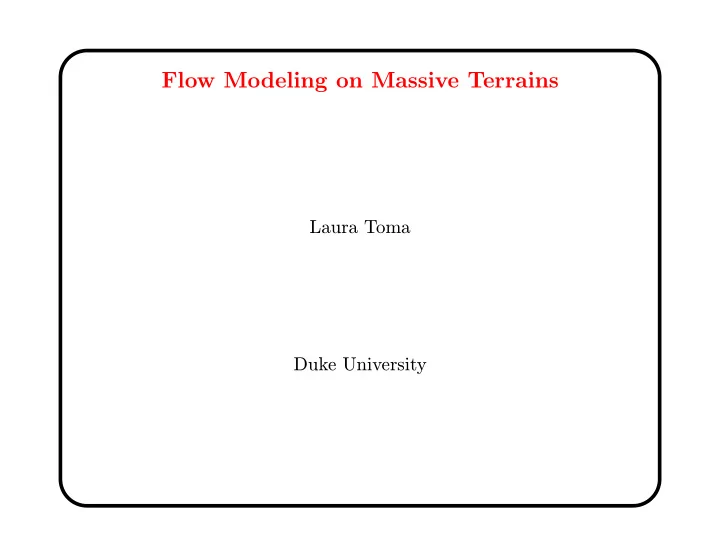

Flow Modeling on Massive Terrains Laura Toma Duke University
Flow Modeling on Massive Terrains Flow Modeling ✫ Flow direction The direction water flows at a point in the terrain. ✫ Flow accumulation value Total amount of water which flows through a point in the terrain. Objective ✫ Flow routing: Compute flow directions for all points in the terrain . ✫ Flow accumulation: Compute flow accumulation values for all points in the terrain . Laura Toma 2
Flow Modeling on Massive Terrains Applications ✫ Watersheds, drainage network ✫ Erosion, infiltration, drainage, solar radiation distribution, sediment transport, vegetation structure, species diversity Laura Toma 3
Flow Modeling on Massive Terrains Flow Routing 3 2 4 3 2 4 ✫ Water flows downhill. 7 5 8 7 5 8 7 1 9 7 1 9 ✫ Compute flow directions by inspecting 8 neighbor cells. ✫ Flat areas: plateaus and sinks. Laura Toma 4
Flow Modeling on Massive Terrains Flow Accumulation ✫ Compute the total amount of flow through each grid point • Initially one unit of water on each grid point • Every point distributes water to the neighbors pointed to by its flow direction(s) Laura Toma 5
Flow Modeling on Massive Terrains Scalability to Massive Data ✫ Massive remote sensing data available • USGS: entire US at 10m resolution; 3m and 1m resolution available • NASA’s Shuttle Radar Topography Mission: collect data for 80% of earth’s land mass (10 terabytes) • LIDAR ✫ Existing software • ArcInfo: cannot process files > 2 GB • GRASS, TARDEM: run for weeks.. Laura Toma 6
Flow Modeling on Massive Terrains I/O-Efficient Flow Routing ✫ Flow routing • Every cell has flow direction • Flow directions do not induce cycles • Every cell has a flow path to the edge of the terrain ��� ��� ��� ��� ��� ��� ��� ��� ��� ��� ��� ��� ��� ��� ��� ��� ��� ��� ��� ��� ��� ��� ✫ ��� ��� ��� ��� Plateaus ��� ��� ��� ��� ��� ��� ��� ��� ��� ��� ��� ��� ��� ��� ✫ Sinks Flooding: Fill the terrain up to the steady state level reached • when an infinite amount of water is poured onto the terrain and the outside is viewed as a giant ocean. Laura Toma 7
Flow Modeling on Massive Terrains Flooding ������������ ������������ ������������ ������������ ������������ ������������ ������������ ������������ ������������ ������������ ������������ ������������ ������������ ������������ ������������ ������������ ��������� ��������� ��������� ��������� ��������� ��������� ��������� ��������� ��������� ��������� ��������� ��������� ��������� ��������� ✫ Previous work: Jenson & Domingue ’88 • Watershed: part of the terrain that flows into the sink. • Partition the terrain into watersheds − → watershed graph • Identify and collapse cycles in the watershed graph • W = number of watersheds: O ( W 2 ) time, O ( W 2 ) I/Os ✫ I/O-efficient flooding: O ( W · α ( W, N )) time and I/Os Laura Toma 8
Recommend
More recommend